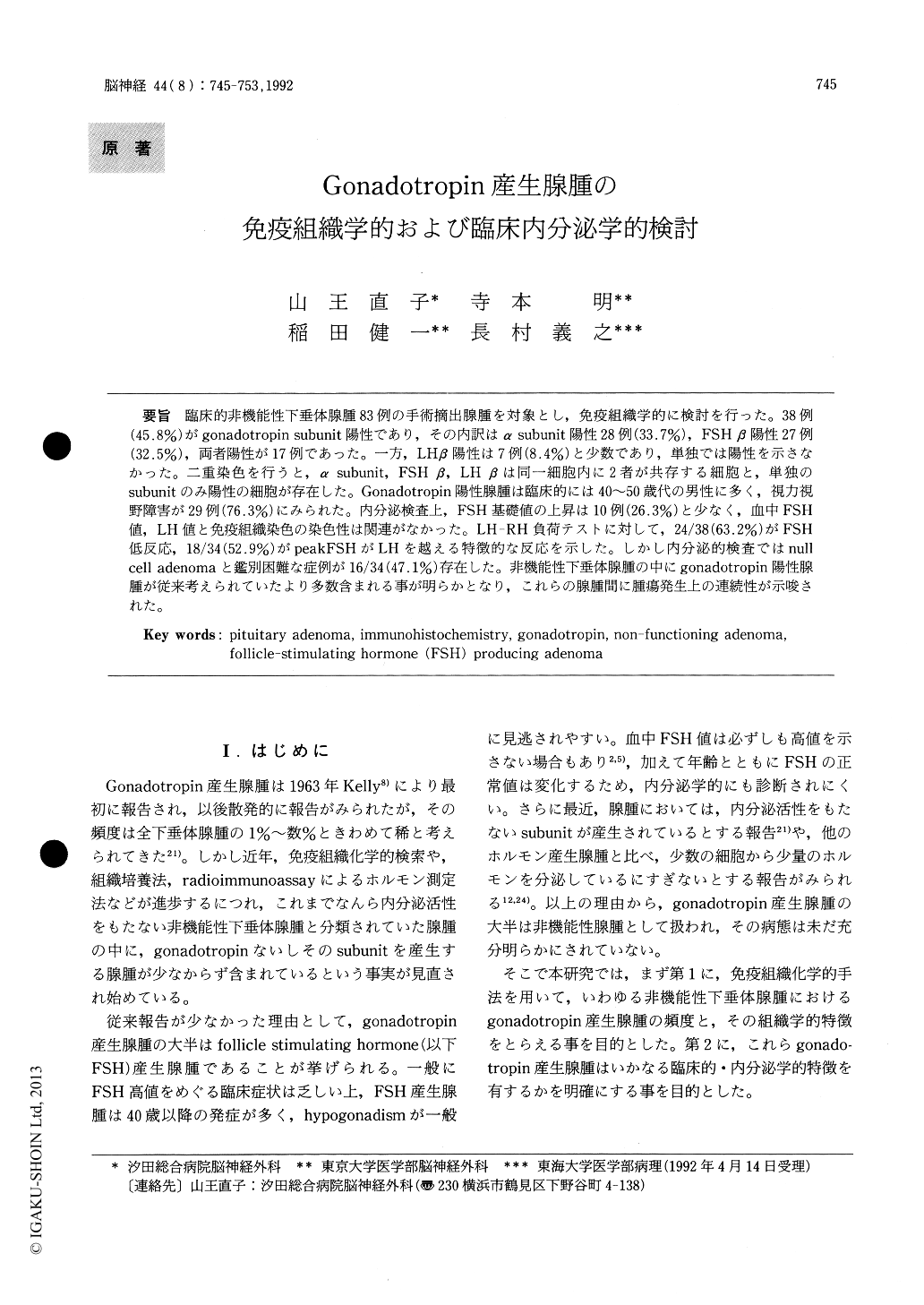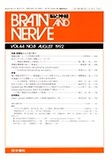Japanese
English
- 有料閲覧
- Abstract 文献概要
- 1ページ目 Look Inside
臨床的非機能性下垂体腺腫83例の手術摘出腺腫を対象とし,免疫組織学的に検討を行った。38例(45.8%)がgonadotropin subunit陽性であり,その内訳はα subunit陽性28例(33.7%),FSHβ陽性27例(32.5%),両者陽性が17例であった。一方,LHβ陽性は7例(8.4%)と少数であり,単独では陽性を示さなかった。二重染色を行うと,α subunit, FSHβ,LHβは同一細胞内に2者が共存する細胞と,単独のsubunitのみ陽性の細胞が存在した。Gonadotropin陽性腺腫は臨床的には40〜50歳代の男性に多く,視力視野障害が29例(76.3%)にみられた。内分泌検査上,FSH基礎値の上昇は10例(26.3%)と少なく,血中FSH値,LH値と免疫組織染色の染色性は関連がなかった。LH-RH負荷テストに対して,24/38(63.2%)がFSH低反応,18/34(52.9%)がpeakFSHがLHを越える特徴的な反応を示した。しかし内分泌的検査ではnullcell adenomaと鑑別困難な症例が16/34(47.1%)存在した。非機能性下垂体腺腫の中にgonadotropin陽性腺腫が従来考えられていたより多数含まれる事が明らかとなり,これらの腺腫間に腫瘍発生上の連続性が示唆された。
In order to study the secretion of gonadotropins in clinically non-functioning pituitary adenomas, 83 cases were investigated by immunohistochemistry.
Expression of one or more of gonadotropinsubunits (α-subunit, follicle-stimulating hormone (FSH) β, luteinizing hormone (LH) β) was found in 38 (45.8%) of all adenomas studied.
α subunit and FSH β were positive in 28 (33.7%) and 27 (32.5%) cases respectively, whereas LH β was detected in seven (8.4%) adenomas.The pres-ence of both α subunit and FSH β was found in 17 cases, while α subunit was singly positive in 11 cases and FSH β, in 10 cases. LH β was not detected alone, but was always accompanied by α subunit or FSH β.
By the double staining method, α subunit and FSH β were not always colocalized in the same cells. Some cells were found to contain both α subunit and FSH β, but others contained either α subunit or FSH β.
Clinical characteristics of gonadotropin positive adenomas (38 cases) were studied in comparison with null cell adenomas (37 cases), which were negative for all anterior pituitary hormones.
The former (male 27, female 11) ranged in age from 21-74 years old (mean, 46.5yr.), and the latter (male 16, female 21) from 28-68yr (mean, 49.5yr.). Gonadotropin positive adenomas tended to occur in middl - eaged men. All 38 adenomas were macro-adenomas, and 29 patients complained of visual failure. Clinical symptoms accompanied by hyperse-cretion of FSH was infrequent. Hypogonadism (ammenorrhea, galactorrhea, loss of libido) were observed in 8 (9.6%) cases.
Endocrinologically, the basal serum levels of gonadotropin were variable, although 10 (26.3%) patients showed abnormally high serum FSH con-centrations.
The response of serum FSH to LH-RH (luteiniz-ing hormone-releasing hormone) was poor in 24 (63. 2%) cases of gonadotropin positive adenomas and in 19 (51.4%) cases of null cell adenomas.Peak FSH values in LH-RH stimulation were greater than those of LH in 18 (52.9%) cases of gonadotropin positive adenomas and 10 (32.3%) cases of null cell adenomas.
Our immunohistochemical and endocrinological studies suggest that the incidence of gonadotropin producing pituitary adenomas may be more fre-quent than hitherto suspected, and that a continuous transition may exist between gonadotropin produc-ing adenomas and null cell adenomas.

Copyright © 1992, Igaku-Shoin Ltd. All rights reserved.


